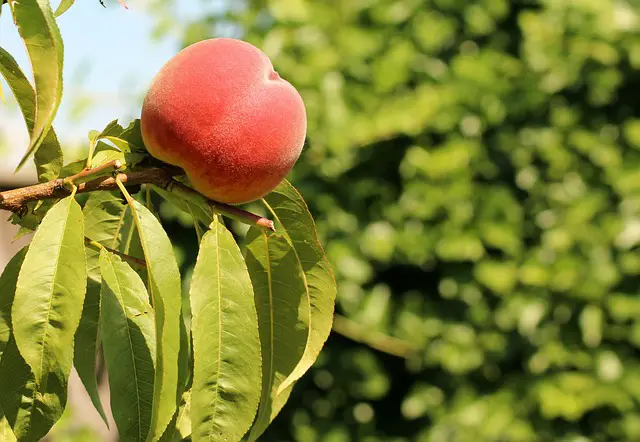
There are definite bonuses to gardening in a climate with mild winters (love that early spring!). But there are some serious disadvantages, too – particularly when growing fruit trees. Many fruit trees need a period of cold to produce fruit. Peach trees are no exception – they need a certain number of “chill hours” (the amount of time spent between 32° and 45°F) to complete the fruiting cycle.
Luckily, horticulturalists and plant geneticists have developed peach varieties that are adapted to growing in warm climates. But what other issues might extreme heat cause? I may not be able to stay cool all summer, but how can I keep my peach tree from stressing in the heat?
To grow peaches in hot climates, choose peach cultivars that need fewer chill hours and can be harvested before the extreme heat of summer. Mitigate heat stress with regular deep watering, shading, whitewashing the trunk, and mulching.
There are many ways to help peach trees thrive, and those growing in hot climates may need a little extra TLC. Read on to find out how to choose, plant, and care for your peach tree through even the worst hot weather. Those delicious fresh-picked peaches are worth a little sweat.
Choosing the Right Peach Tree for the Heat
If you live in an area with mild winters, it’s essential to plant peach varieties with chill-hour requirements that correspond to the average chill hours for your area. For more details about chill hours for peaches and how to find out your area’s average, read The Best Low-Chill Peach Trees for Warm Climates.
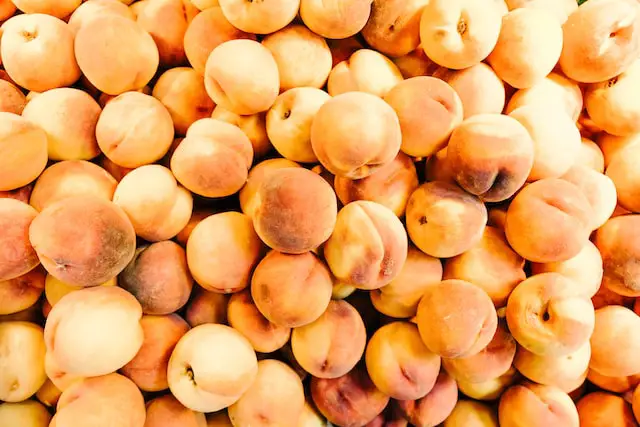
Low-chill peaches are not necessarily the same as heat-tolerant peaches. Some peach cultivars have a relatively high chill-hour requirement and are well suited to colder climates, but are still considered heat tolerant (such as ‘Sentinel’).
Peach trees grown in very hot, humid areas will experience more insect and disease pressure than those in temperate zones. The greater susceptibility to diseases and pests may mean the tree’s lifespan will be somewhat shorter.
Pests and disease can be managed with a regular spray schedule, however, and the resulting peaches will be well worth the effort. Check out my article about dormant peach tree spraying for all the how-to info you need.
In hot climates, consider choosing an early-fruiting peach variety. Peaches can be ready for harvest anywhere from May to August, depending on the cultivar. Selecting a variety that fruits early means the peaches will ripen before the heat of midsummer arrives and stresses the tree. Just be sure to double-check your last frost date – a late frost can kill early spring buds and ruin that year’s peach crop.
TIP: Choose an early-ripening peach variety so the fruit is ready to pick before the intense heat of summer.
Signs of a heat-stressed peach tree include: wilting, yellowing, or dropping leaves, dried leaf edges, cupping or rolled leaves, and scorching or blistering of the fruit. Just like humans, fruit trees can get sunburned, and excessive heat leads the tree to lose more water than it takes in.
Planting Peach Trees in Hot Climates
The best time to plant a new peach tree is in the late winter or early spring while the plant is dormant. There will be less stress on the newly planted tree because it is in a state of rest. The energy needs to grow and produce fruit in the spring and summer was stored up in the previous season, so by the time the heat of summer arrives, it will be on its way to being well-established.
Second to planting in dormancy, the next best option is to plant during the cooler months of spring or fall. We all know, however, how rarely things are done in ideal circumstances when it comes to gardening. How easy it is to leave the peach tree in its nursery pot a little too long, and before you know it, it’s summer and you have to get it into the ground.
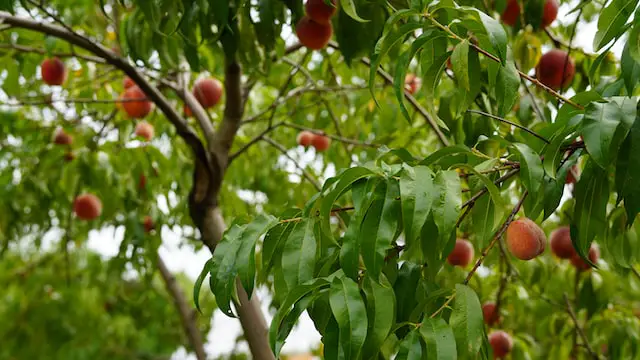
Planting a peach tree in the heat of summer will, without a doubt, put the tree under stress, but there are certain things you can do to keep transplant shock to a minimum:
- Choose the right spot. Take advantage of cooler microclimates in your landscape. Look for low points (where you notice frost settling a little heavier) and spots that are more exposed to breezes. A slightly cooler temperature (and a small increase in overall chill hours) can alleviate extreme heat stress and help the tree fruit better.
- Make sure the soil has good drainage. Dig a shallow, wide hole at least 3 times the width of the pot. Fill the hole halfway with native soil, then fill the rest with a mixture of native soil amended with compost (you can also add some expanded shale to help with drainage). Bagged “garden” or potting soil can retain too much moisture, leading to root rot.
- Water in thoroughly. Soak the root ball completely, but also water the soil under and around the tree. Then leave it alone for about a week before watering again. Add a diluted (half-strength) solution of liquid seaweed fertilizer in the second watering to help reduce transplant shock and strengthen root growth.
- Use a light mulch. When the tree is first planted, mulch should shade the soil but still be breathable. A thick layer of heavy mulch will keep heat trapped near the roots, increasing heat stress. Use something lightweight, such as shredded leaves, straw, or cypress mulch.
- Keep the tree shaded the first year. During the strongest summer heat, keep the tree partially shaded (about 35-50%), particularly during the hottest part of the day. Use a breathable, woven material – an old sheet, burlap, or other cloth – rather than a tarp or plastic. You can even use old umbrellas if you have a way to suspend them. Stake the shade material high enough to provide good airflow. When the tree begins to show some growth, and when the intense heat has passed, gradually reduce the amount of shade to acclimate the tree to full sun exposure.
Caring for Peach Trees in Hot Climates
Even after a peach tree is established, hot weather could still cause the tree to stress. A tree that is generally healthy and well cared for will withstand extreme temperatures better than one that is already weak or malnourished.
Good, standard care includes regular pruning to maintain an open shape and eliminate crossing or rubbing internal branches. See A Simple Guide to Pruning Peach Trees for Maximum Harvest for easy pruning instructions.
It is also a good practice to thin fruit on the tree to keep branches from breaking and causing further stress to the tree. When the peaches are about 1-inch in diameter, thin so that there are about 6-8 inches of space between fruits. (For more info on how and why to thin peaches, check out my article here.)
During hot, dry spells, water the peach tree regularly (up to once a week). It is better to water less frequently but deeply, as shallow watering will encourage shallow root growth – and roots too close to the surface will dry out quicker in the heat.
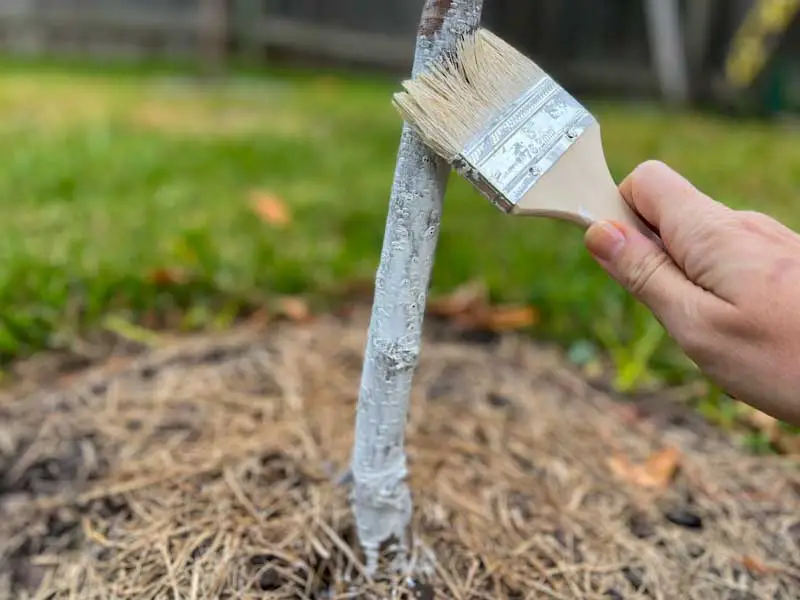
A great way to protect fruit trees from heat stress is by whitewashing the trunk and any exposed branches. Mix a 3:1 ratio of water to white interior latex (water-based) paint, then spread it on the trunk of the tree.
An even better option is to use an organic product such as this (which also comes in brown or green). The white color reflects heat and keeps the tree cooler, similarly to how wearing light colors on a hot day keeps your body cool, but the green or brown won’t be as noticeable in the garden.
In addition to reflecting heat, whitewashing creates a protective layer that also guards against rodent damage (they love to nibble on young tree trunks), disease pathogens, insects, and sun-scald in the winter.
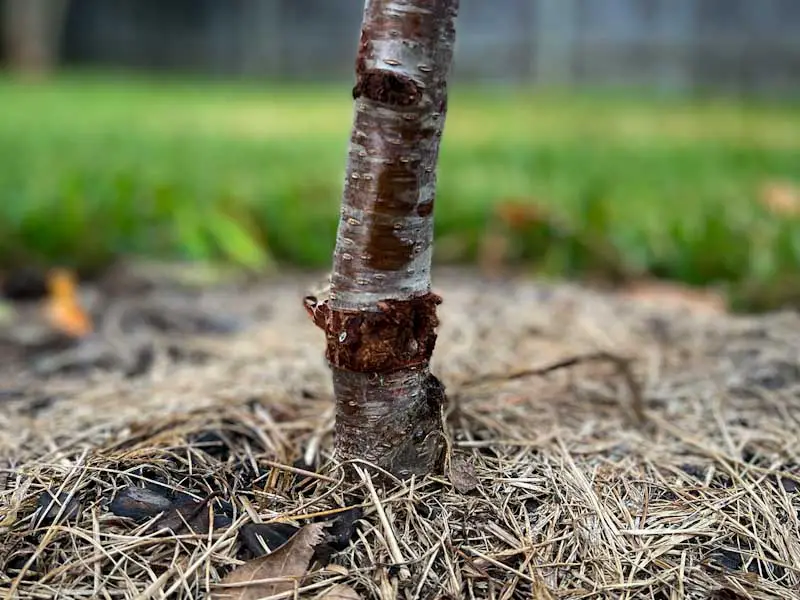
Heat-Tolerant Peach Varieties to Try
There are hundreds of peach cultivars, and you can find varieties suitable for growing in just about any climate. Below are a few of our favorites to grow in warm climates – they are all heat tolerant, have moderate to low chill requirements, and are absolutely delicious. (For a more extensive list, check out The Best Peaches to Grow for Fresh Eating.)
- ‘Earligrande’ – sweet yellow flesh, yellow skin with red blush, semi-freestone, 300 chill hours, ripens in late May to early June
- ‘Desert Gold’ – sweet, firm yellow flesh, semi-freestone, 250-350 chill hours, ripens in early July
- ‘FlordaPrince’ – firm yellow flesh, reddish-yellow skin, 150 chill hours, ripens in mid-May
- ‘Bonanza’ dwarf – yellow, sweet, freestone, 450 chill hours, ripens in mid-to-late June
- ‘Santa Barbara’ – sweet yellow flesh, yellow skin with pink blush, freestone, 200-300 chill hours, ripens in early July
- ‘White Delight Two’ – creamy white flesh, rosy skin, low-acid, semi-freestone, 500-600 chill hours, ripens late May to early July
- ‘Babcock’ – white flesh tinged with red, pink/red skin, low fuzz, freestone, 200-300 chill hours, ripens in early July
- ‘Tropic Snow’ – white flesh, freestone, 200 chill hours, ripens mid-to-late May

